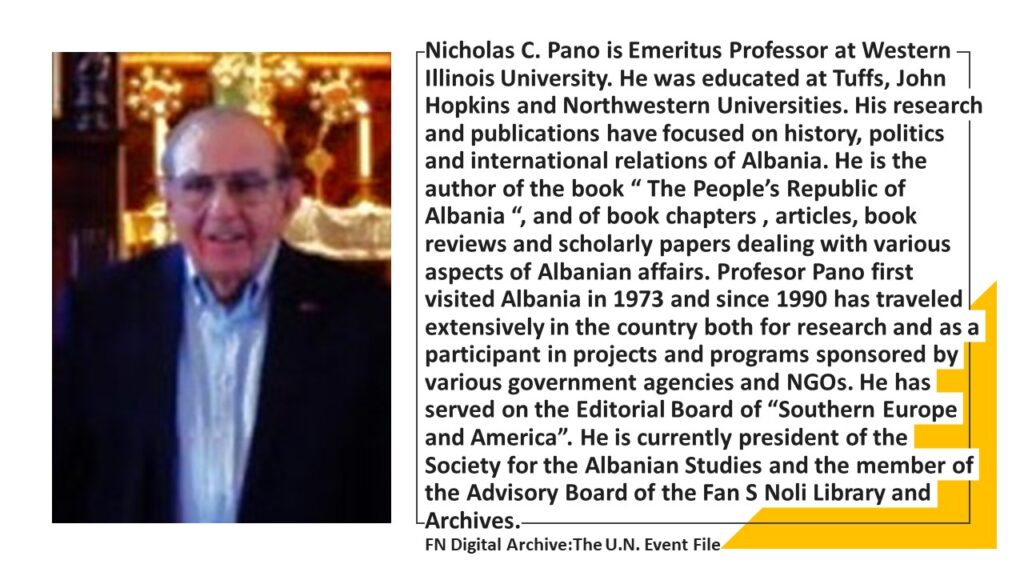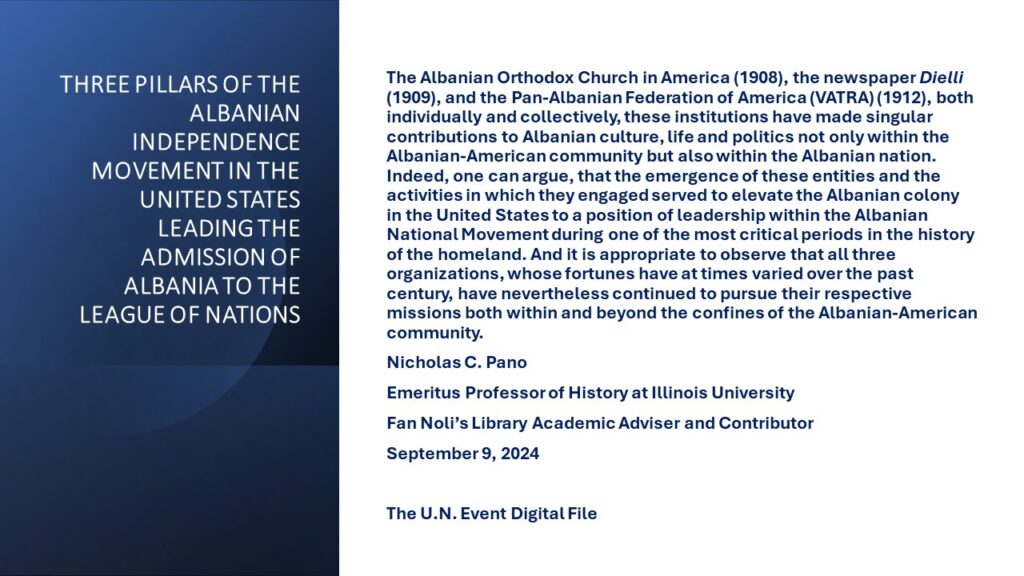

Nicholas C. Pano/
It is important in the context of Fan Noli’s numerous and multi-faceted contributions to the Albanian National Renaissance both to acknowledge and emphasize the significant roles he played in the organization and activities of the three institutions that comprise the historic pillars of the Albanian-American community. The institutions are: the Albanian Orthodox Church in America(1908), the newspaper Dielli (1909), and the Pan-Albanian Federation of America(VATRA)(1912). Both individually and collectively, these institutions have made singular contributions to Albanian culture, life and politics not only within the Albanian-American community but also within the Albanian nation. Indeed, one can argue, that the emergence of these entities and the activities in which they engaged served to elevate the Albanian colony in the United States to a position of leadership within the Albanian National Movement during one of the most critical periods in the history of the homeland. And, it is appropriate to observe that all three organizations, whose fortunes have at times varied over the past century, have nevertheless continued to pursue their respective missions both within and beyond the confines of the Albanian-American community.
The establishment of the Albanian Orthodox Church(1908) with the ordination of Fan Noli enabled the Albanians of this faith to worship in their own language and to refute Greek church and government claims that all Orthodox Albanian Christians were Greek . This initiative also spurred efforts by homeland Orthodox Albanians to obtain autocephalous status for their church, a goal finally realized in 1937. In this sense, the Albanian Orthodox Church in America can be considered as the “mother church” of its homeland counterpart.
Although Noli was less directly involved in his ecclesiastic mission during his period of intensive political engagement and exile, 1920-1932, he resumed his active and constructive role in church affairs upon his return to the United States during the latter year. Noli, during the final 33 years of his life, focused much of his effort on providing Albanian and English translations of liturgical works for use in church services and catechesis. He also took the requisite measures to regularize the administrative structure of the Church as well as to provide for a well trained clergy. And, in a final gesture to safeguard the independence of the Church, Noli arranged for the episcopal ordination of Father Stephan Lasko as his designated successor.
Although the Church would experience a period of turmoil following Noli’s death in 1965, it has entered into a period of relative stability since 1971 as the Abanian Archdiocese (with 13 parishes) of the Orthodox Church of America under the leadership of the most recent of Noli’s successors, Bishop Nikodhim. In respect to the Noli legacy, it should also be noted that the Fan Noli Library and Archives established on the premises of St. George Cathedral by the late Father Arthur Liolin and curated by Neka Doko has over the past half century emerged as a major repository of Noliana.
Fan Noli was instrumental in founding Dielli in 1909. He served as its first editor and resumed that position on several other occasions. Both under his own name or a variety of pseudonyms Noli continued to contribute articles, poems, literary translations and other materials to the newspaper throughout his lifetime. In the course of its lengthy history as the oldest continuously published Albanian-language newspaper in the world, Dielli on numerous occasions has served to mobilize the Albanian-American community during critical periods in the history of Albania and the Albanian Nation. Noli, I suspect, would be as delighted, as those of us long-time readers of Delli, by the ongoing qualitative improvements to this historic newspaper and its website over the past two decades.
Noli and Faik Konica were the prime movers in the establishment of VATRA(The Pan-Albanian Federaton of America) in April 1912 following an agreement on the part of a majority of the leaders of the Albanian patriotic societies in the United States to merge the existing groups into a national organization that could more effectively advocate in behalf of Albanian interests both in the United States and abroad. In this connection, VATRA assumed responsibility for printing Diell, which by 1915 was being published on a daily basis and also produced and circulated between 1918-19 an English language publication, the Adriatic Review to sensitize U. S. and European opinion elites to Albanian concerns. During the World War I era VATRA raised some $200,000(c. $4 million) to finance its public relations and lobbying efforts and to support an Albanian delegation at the Paris Peace Conference. And following the end of the war, VATRA continued to provide a modest, but welcome, degree of economic and moral support to Albania until 1924.
VATRA’s contributions to Albania between 1912-24 alone underscore the fact that it was the most important and impactful of the organizations established by Noli, Konica and their contemporaries. Although Noli ‘s anti-Zog stance alienated him from VATRA and Konica between 1924-34, when this rift was healed. Following his reconciliation with VATRA, Noli once again made common cause with the organization in combating challenges to the homeland, his Church and VATRA itself. In his declining years Noli assumed the status of a respected elder statesman within the organization until his passing in 1965.
In sum, in order to appreciate the full dimensions of Noli’s roles in the Albanian National Renaissance, it is important to recognize his contributions that transformed the Albanian-American community into the leading external center of this movement during the first two decades of the 20th century.